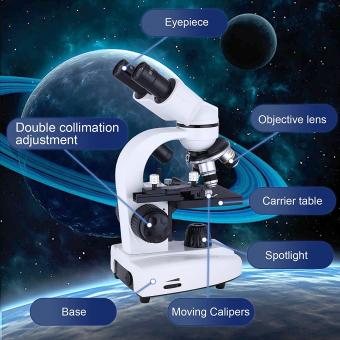What Does Dna Look Like Under A Microscope ?
DNA cannot be seen under a regular light microscope as it is too small. However, it can be visualized using specialized techniques such as electron microscopy or fluorescence microscopy. In electron microscopy, DNA is stained with heavy metals and then imaged using a beam of electrons. In fluorescence microscopy, DNA is labeled with fluorescent dyes that emit light when excited by a specific wavelength of light. This allows for the visualization of DNA within cells or on a microscope slide. The structure of DNA can also be inferred from X-ray crystallography, which involves crystallizing DNA and then analyzing the diffraction pattern of X-rays that are shone through the crystal. This technique has been used to determine the double helix structure of DNA.
1、 Double helix structure

DNA, or deoxyribonucleic acid, is the genetic material that carries the instructions for the development and function of all living organisms. When viewed under a microscope, DNA appears as a double helix structure, resembling a twisted ladder. The two sides of the ladder are made up of nucleotides, which are the building blocks of DNA. Each nucleotide consists of a sugar molecule, a phosphate group, and a nitrogenous base. The nitrogenous bases, which include adenine, thymine, guanine, and cytosine, pair up in a specific way, with adenine always pairing with thymine and guanine always pairing with cytosine. This base pairing is what gives DNA its characteristic double helix shape.
Recent advances in microscopy techniques have allowed scientists to study DNA in even greater detail. For example, super-resolution microscopy has enabled researchers to visualize the three-dimensional structure of DNA within the nucleus of a cell. This has revealed that DNA is not randomly arranged within the nucleus, but instead forms distinct structures known as chromatin. Chromatin consists of DNA wrapped around proteins called histones, which help to package the DNA into a compact form that can fit within the nucleus. The precise organization of chromatin is important for regulating gene expression, as it can affect how easily the DNA is accessible to the cellular machinery that reads and transcribes the genetic code.
2、 Nucleotide base pairs

Under a microscope, DNA appears as a long, thin, and twisted ladder-like structure. This structure is known as a double helix, which consists of two strands of nucleotide base pairs. The nucleotide base pairs are made up of four different nitrogenous bases: adenine (A), thymine (T), guanine (G), and cytosine (C). These bases pair up in a specific way, with A always pairing with T and G always pairing with C. The two strands of the double helix are held together by hydrogen bonds between the base pairs.
Recent advancements in microscopy techniques have allowed scientists to visualize DNA at an even higher resolution. Cryo-electron microscopy (cryo-EM) has been used to capture images of DNA at the atomic level. This technique involves freezing the DNA in a thin layer of ice and then imaging it with an electron microscope. With cryo-EM, scientists have been able to see the individual atoms that make up the nucleotide base pairs and the hydrogen bonds that hold the two strands of the double helix together.
In addition to its structural appearance, DNA also plays a crucial role in the storage and transmission of genetic information. The sequence of nucleotide base pairs in DNA determines the genetic code that is used to create proteins and carry out other cellular functions. Understanding the structure and function of DNA is essential for many fields of science, including genetics, molecular biology, and biotechnology.
3、 Sugar-phosphate backbone

DNA, or deoxyribonucleic acid, is a complex molecule that contains the genetic information of an organism. When viewed under a microscope, DNA appears as a long, thin strand that is coiled and twisted into a double helix shape. The double helix structure of DNA was first discovered by James Watson and Francis Crick in 1953, and it has since become one of the most iconic images in science.
The double helix structure of DNA is formed by two strands of nucleotides that are held together by hydrogen bonds. The nucleotides themselves are made up of three components: a sugar molecule, a phosphate group, and a nitrogenous base. The sugar and phosphate molecules form the backbone of the DNA strand, while the nitrogenous bases project inward and form the "rungs" of the ladder.
Recent advances in microscopy technology have allowed scientists to study DNA at an even higher level of detail. For example, super-resolution microscopy techniques have revealed that the double helix structure of DNA is not always perfectly uniform, and that there can be variations in the spacing between the nucleotides. Additionally, researchers have used cryo-electron microscopy to capture images of DNA in action, such as during the process of transcription, where the genetic information in DNA is used to create RNA molecules.
Overall, while the basic structure of DNA has been known for decades, advances in microscopy technology continue to reveal new insights into the complex and fascinating world of genetics.
4、 Width of 2 nanometers

DNA, or deoxyribonucleic acid, is the genetic material that carries the instructions for the development and function of all living organisms. Under a microscope, DNA appears as a long, thin, and twisted double helix structure. The width of DNA under a microscope is approximately 2 nanometers, which is incredibly small and requires advanced imaging techniques to visualize.
Recent advancements in microscopy have allowed scientists to study DNA in greater detail than ever before. For example, super-resolution microscopy techniques such as STED (stimulated emission depletion) microscopy and PALM (photoactivated localization microscopy) can achieve resolutions of less than 10 nanometers, allowing researchers to observe individual molecules of DNA.
In addition to its characteristic double helix structure, DNA can also form other shapes and structures depending on its environment and interactions with other molecules. For example, DNA can form loops, knots, and even three-dimensional structures called chromatin. These structures play important roles in regulating gene expression and other cellular processes.
Overall, the study of DNA under a microscope has provided invaluable insights into the fundamental processes of life and has paved the way for advances in fields such as genetics, biotechnology, and medicine.






































